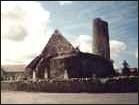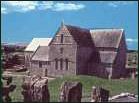



















|

The Tóchar Valley
 A beautiful area of rural communities stretching from Balla to Murrisk, at the foot of
Croagh Patrick, "Ireland's Holy Mountain". Steeped in antiquity, the unspoiled countryside is liberally sprinkled with churches, Celtic artifacts
and historical sites. The Tóchar Phádraig pilgrim route, which links these townlands and villages for a distance
of 55km., is the ancient pilgrim pathway to Croagh Patrick.
A beautiful area of rural communities stretching from Balla to Murrisk, at the foot of
Croagh Patrick, "Ireland's Holy Mountain". Steeped in antiquity, the unspoiled countryside is liberally sprinkled with churches, Celtic artifacts
and historical sites. The Tóchar Phádraig pilgrim route, which links these townlands and villages for a distance
of 55km., is the ancient pilgrim pathway to Croagh Patrick.
 Ballintubber Abbey
This 13th century abbey is unique, not only is it the only church in Ireland still in use which was founded by an
Irish King, but it is also the one Irish church where for over 781 years Mass has been offered without a break.
Its story is graphically told in a video documentary on show at the abbey. Founded in 1216 by the last King
of Connaught, Cathal Crovdearg O'Connor, for the Canons Regular of St. Augustine order, the Abbey had large tracts
of land in the district until the dissolution of the Monasteries by King Henry VII.
Retreats, pilgrimages and tours are available today.
The Celtic Furrow Visitors Centre provides guided tours of the region, tracing 5,000 years of Irish culture. Ballintubber Abbey
This 13th century abbey is unique, not only is it the only church in Ireland still in use which was founded by an
Irish King, but it is also the one Irish church where for over 781 years Mass has been offered without a break.
Its story is graphically told in a video documentary on show at the abbey. Founded in 1216 by the last King
of Connaught, Cathal Crovdearg O'Connor, for the Canons Regular of St. Augustine order, the Abbey had large tracts
of land in the district until the dissolution of the Monasteries by King Henry VII.
Retreats, pilgrimages and tours are available today.
The Celtic Furrow Visitors Centre provides guided tours of the region, tracing 5,000 years of Irish culture.
 Croagh Patrick Croagh Patrick
Ireland's Holy Mountain has drawn pilgrims in their droves since pre-christian times. It has a magnetic attraction and
many of the faithful continue to climb barefoot, especially on Reek Sunday, the last Sunday in July. A small
church at the summit marks where St. Patrick spent 40 days in contemplation and prayer.
An archaeological excavation licensed by the National Monuments service showed that Croagh Patrick
was a place of tremendous importance in the pre-Christian era, as indicated by the discovery of a
Celtic hill fort encircling the summit. The exciting discovery of a dry stone oratory, akin to the Gallarus
Oratory in County Kerry, has been radiocarbon dated to between 430 and 890 AD.
 Foxford Woolen Mills & Visitors Centre Foxford Woolen Mills & Visitors Centre
Imagine a unique and thriving woolen mill set in the wild and rugged West of Ireland, famous worldwide for its rugs and tweeds, and blankets.
Established in 1892, by Agnes Morrogh - Bernard, an Irish Sister of Charity, her vision has become a reality at
Foxford Woolen Mills against incredible odds.
Take the industrial tour and experience the sights, sounds and smells of this 19th century woolen mill. Afterwards
relax in the comfortable restaurant and browse through the impressive mill shop.
The Michael Davitt Museum
 (Straide, Foxford) Michael Davitt was the founder of the Land League. The museum contains an extensive collection of documents,
photos, Land Acts, letters, postcards, posters and other items connected with Davitt's life. There is also
the excellent audio-visual which enhances the exhibition and knowledgeable and friendly staff are on hand to
give you a guided tour which encompasses Davitt's grave and also Straide Abbey, if desired.
(Straide, Foxford) Michael Davitt was the founder of the Land League. The museum contains an extensive collection of documents,
photos, Land Acts, letters, postcards, posters and other items connected with Davitt's life. There is also
the excellent audio-visual which enhances the exhibition and knowledgeable and friendly staff are on hand to
give you a guided tour which encompasses Davitt's grave and also Straide Abbey, if desired.
 Knock Shrine & Folk Museum Knock Shrine & Folk Museum
On 22 August 1879 fifteen local people saw a vision of Mary the Mother of Christ. Two church commissions examined
the claim- "The claim was 'trustworthy and satisfactory'".
Now Knock Shrine is one of the major Marian Shrines of the world. Pope John Paul II traveled to Knock as a pilgrim
in 1979. Each year over 1.3 million pilgrims travel to the shrine from all over the world.
Knock Folk Museum documents the story of the Knock Apparition of 1879 and places it in the context of the lifestyle
of the people, their traditions and customs at the time. Permanent displays range from religious to fishing,
farming, crafts and skills, education, housing, clothing and transport.
Céide Fields
 The Céide Fields, Ballycastle are the oldest known field systems in the world, over five and a half millennia old. It is a
unique Neolithic landscape of world importance, which has changed our perception of our Stone Age ancestors.
The remains of stone field walls, houses and megalithic tombs are preserved beneath a blanket of peat over
several square miles. They tell a story of the everyday lives of a farming people, their organized society,
their highly developed spiritual beliefs, and their struggle against a changing environment beyond their control.
Visit the multi-award winning Centre, which has exhibitions, audio-visual show and tearooms.
The Céide Fields, Ballycastle are the oldest known field systems in the world, over five and a half millennia old. It is a
unique Neolithic landscape of world importance, which has changed our perception of our Stone Age ancestors.
The remains of stone field walls, houses and megalithic tombs are preserved beneath a blanket of peat over
several square miles. They tell a story of the everyday lives of a farming people, their organized society,
their highly developed spiritual beliefs, and their struggle against a changing environment beyond their control.
Visit the multi-award winning Centre, which has exhibitions, audio-visual show and tearooms.
 Kiltimagh Museum Kiltimagh Museum
In the 1980s the Historical Society acquired the old Goods Store of Kiltimagh Railway Station and turned it into a
Museum. Two old Railway Carriages were acquired to commemorate the thousands of our people who had had to
emigrate, and these were incorporated into the Museum. Now the Museum houses many artifacts from our past,
such as the Land League Banner, buried for safety in a bog for forty years, the instruments of the 19th century
town band, items from Kiltimagh Lace School, Railway artifacts and many other items reflecting different
aspects of our past.
Museum of Country Life
 Turlough Park, Castlebar. Here you can immerse yourself in the lives of our rural ancestors from
the mid - 19th to the mid - 20th centuries. Lifestyles which were established for several hundred years came to an end well into
living memory, and here amidst furniture and fittings, the tools they used to work the land and the clothes and textiles they wore,
you can reach out and touch those vanished lives.
Turlough Park, Castlebar. Here you can immerse yourself in the lives of our rural ancestors from
the mid - 19th to the mid - 20th centuries. Lifestyles which were established for several hundred years came to an end well into
living memory, and here amidst furniture and fittings, the tools they used to work the land and the clothes and textiles they wore,
you can reach out and touch those vanished lives.
Turlough Park is the site of the first de Burgo castle and the impressive High Victorian Gothic style house was built in
1865 by the Fitzgeralds, who farmed the surrounding land. Today the museum offers guided tours, an audio - visual exhibition,
lectures, workshops, special events, family days, a museum shop & cafe.
|
|
|


|
 |
































